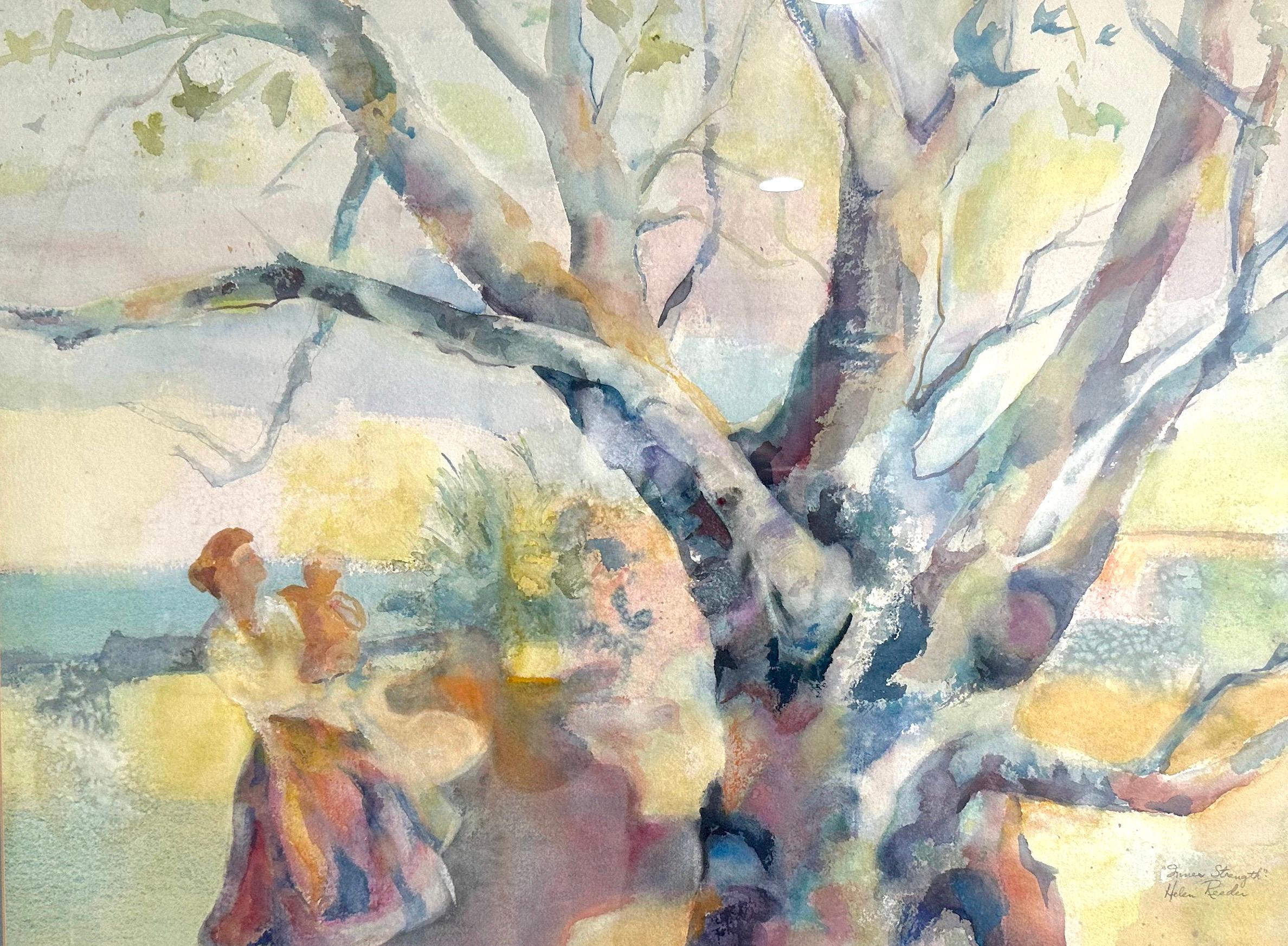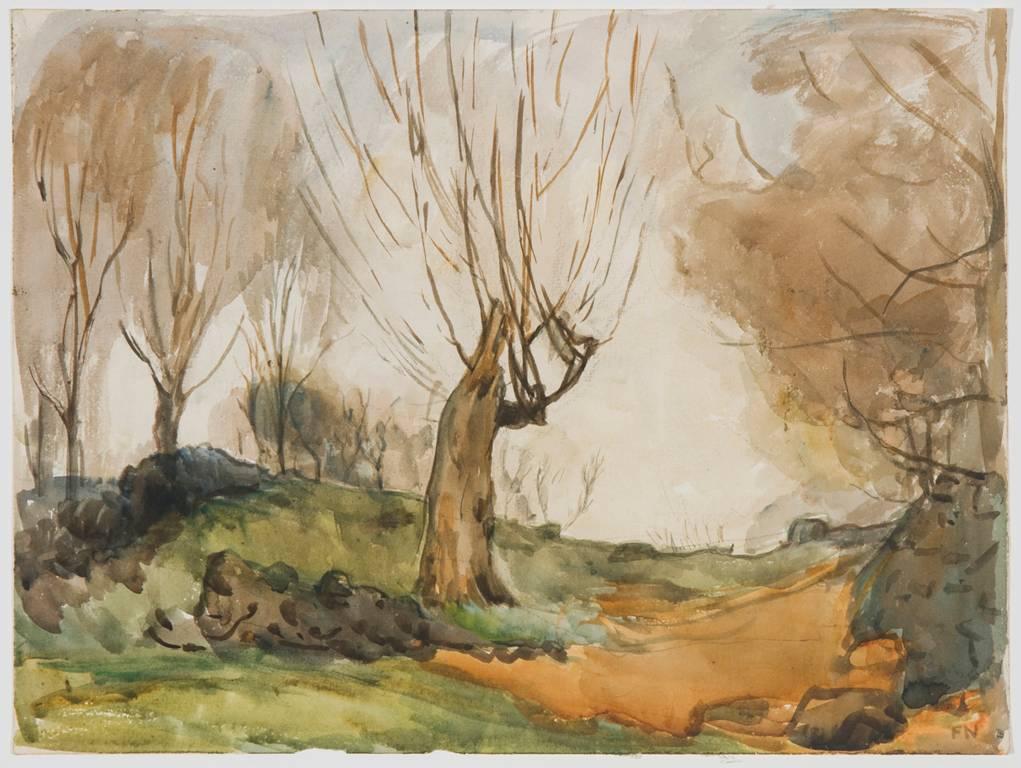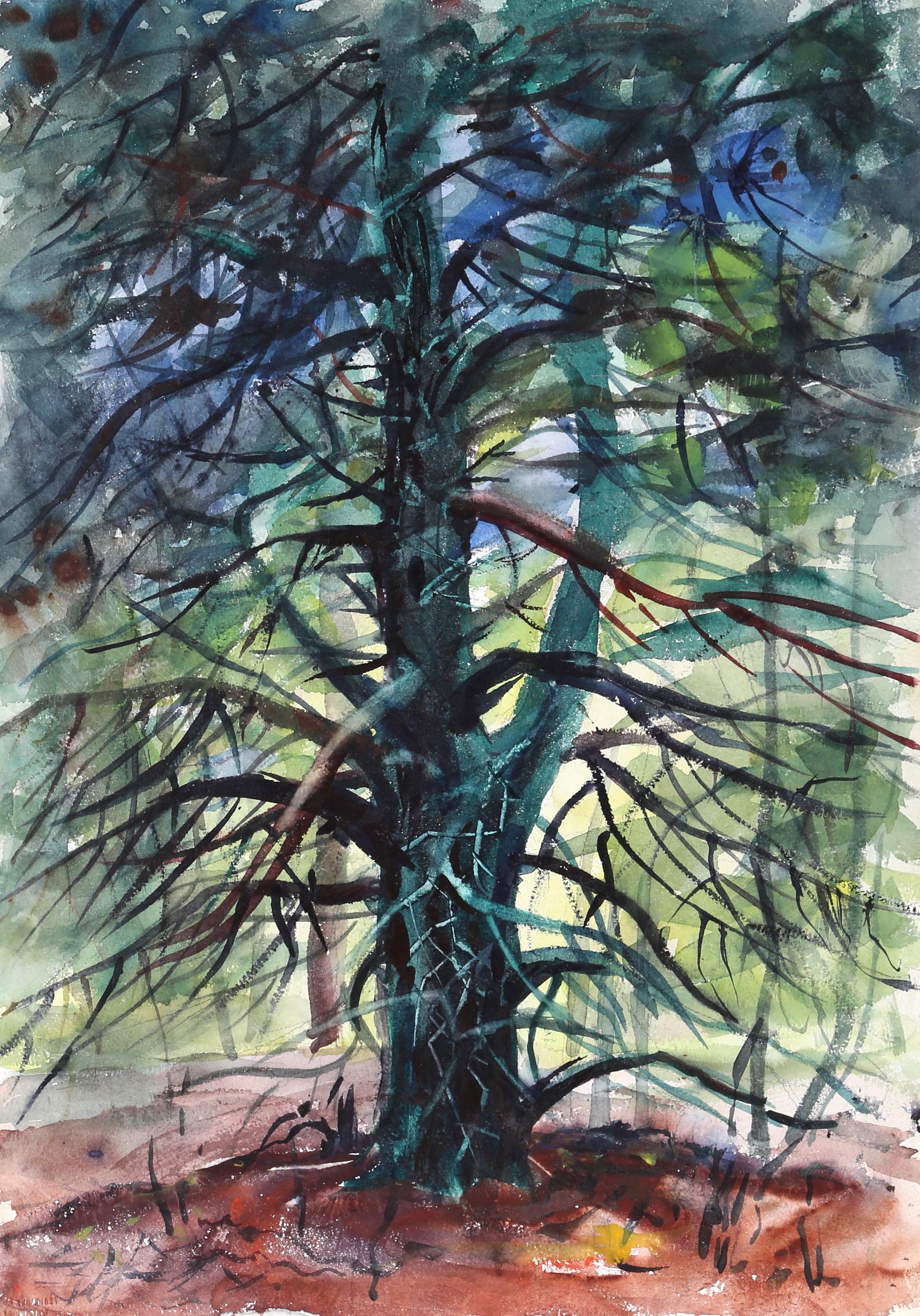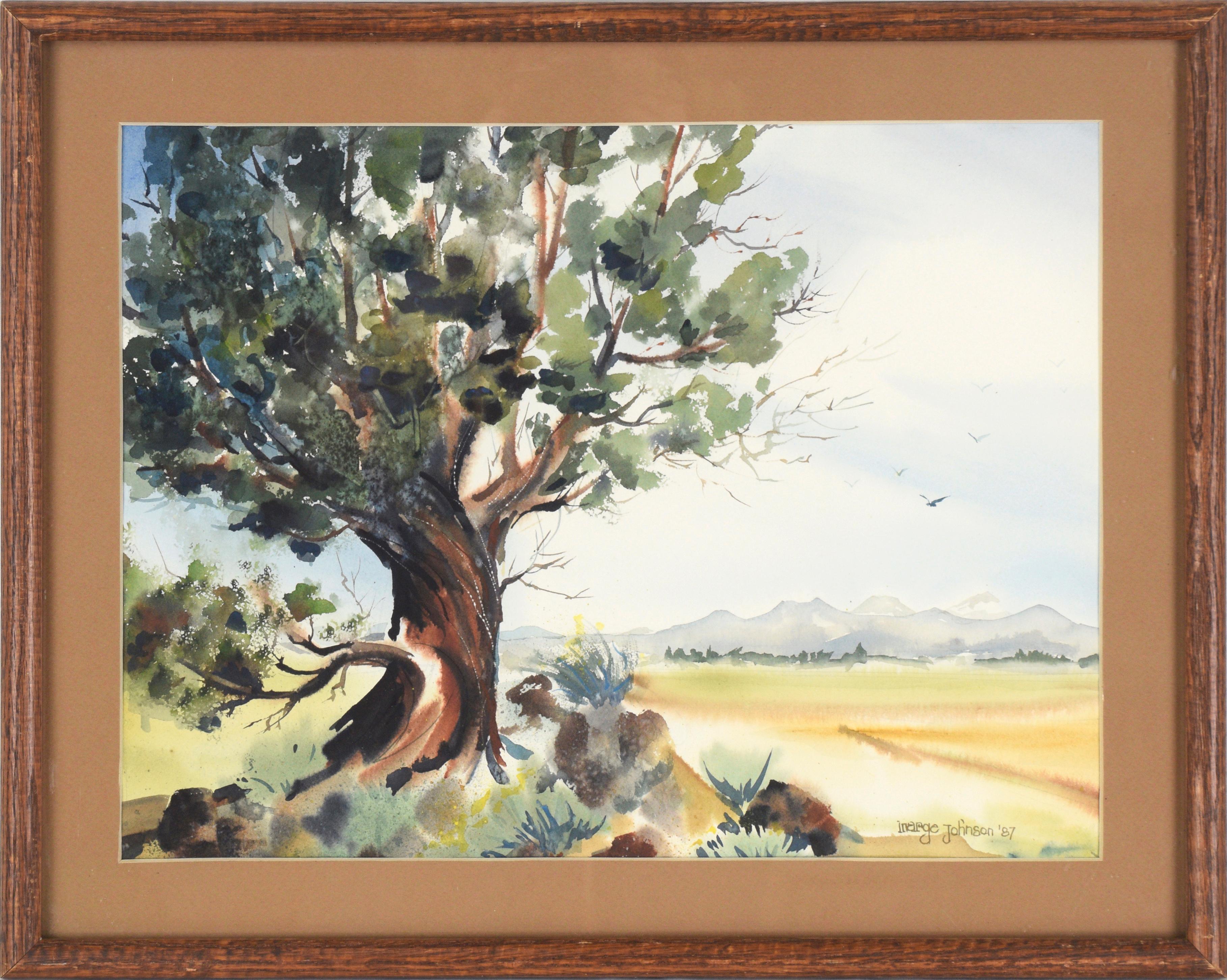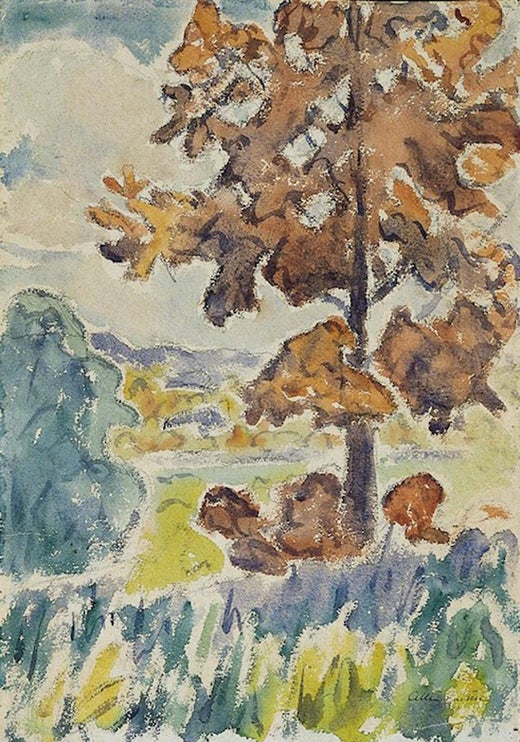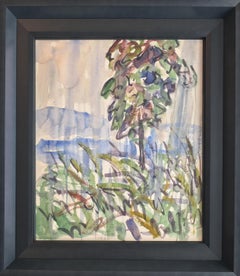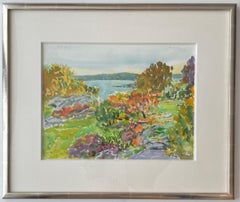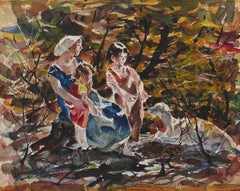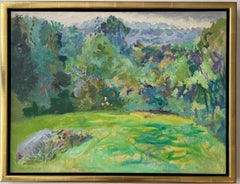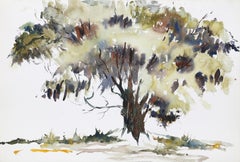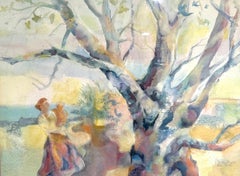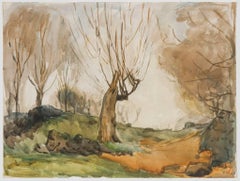Items Similar to Watercolor of the Oak Tree by Allen Tucker
Want more images or videos?
Request additional images or videos from the seller
1 of 10
Allen TuckerWatercolor of the Oak Tree by Allen TuckerCirca 1920-1930
Circa 1920-1930
$3,500
£2,633.67
€3,044.73
CA$4,942.10
A$5,358.68
CHF 2,843.79
MX$65,999.01
NOK 35,246.99
SEK 33,265.06
DKK 22,726.60
About the Item
Landscape watercolor by Allen Tucker of an oak tree. This piece, along with several others, was gifted to Una Brage, a friend of the artist in the 1930s.
More about this artist:
Allen Tucker, was an architect and painter so influenced by Vincent Van Gogh that he was called "Vincent in America". (Gerdts 291) Robert Henri and Maurice Prendergast were also credited as having an influence on Tucker's brushwork and compositions, the latter decisively. However, as his painting evolved, he did not fit into any tidy slot for description and was known as an individualist not easily categorized in American art history.
Tucker was born in Brooklyn in 1866 and graduated from the School of Mines of Columbia University with a degree in architecture and took a job as an architectural draftsman in the architectural firm of McIvaine and Tucker, his fathers business. During that time, he studied painting at the Art Students League with Impressionist John H. Twachtman, but it was not until around 1904, when he was 38, that Tucker became a full-time painter, leaving architecture behind. Many of his early canvases were classically Impressionistic with poplar trees resembling those of Van Gogh and haystacks and corn shocks emulating those of Claude Monet. However, he did not hold to his Impressionist style and explored other kinds of abstraction as well as architectural forms.
He became, in 1911, a charter member of the Association of American Painters and Sculptors, the group that would conceive, organize, select the artists and hang the 1913 Armory Show that shocked many persons by introducing abstract art to America. Tucker helped organize the landmark Armory Show of 1913 and in 1919 was also part of the founding the Society of Independent Artists, a group that rebelled against traditionalism.
In 1918, Tucker had his first large one-man show at the Whitney Studio Club (later the Whitney Museum of American Art) and became an advisor to Mrs. Juliana Force, who directed the Whitney Studio and the Whitney Studio Club. He was an Honorary Member of the Art Students' League, and taught at the League from 1921 to 1928. Tucker also wrote, "Here and There," a book of verse, 1919; "Design and Idea," 1930 and "John Henry Twachtman," 1931. His summers were spent painting in New Mexico, on the New England coast, in the Colorado and Canadian Rockies and in Europe.
Allen Tucker died in New York City in 1939.
His work is in the collections of the Albright-Knox Art Gallery, Buffalo, New York; Art Institute of Chicago; Brooklyn Museum; Metropolitan Museum of Art, New York City; and the Phillips Collection, Washington, D.C.
From David Michael Zellman "Three Hundred Years of American Art"
- Creator:Allen Tucker (1866-1939, American)
- Creation Year:Circa 1920-1930
- Dimensions:Height: 20 in (50.8 cm)Width: 14 in (35.56 cm)
- Medium:
- Movement & Style:
- Period:
- Condition:This piece has some minor tears, but no losses (see photos).
- Gallery Location:Hudson, NY
- Reference Number:Seller: TuAl0021stDibs: LU2465215442692
Allen Tucker
Exposure to the latest artistic currents at the 1913 Armory Show had a profound effect on Tucker's own artistic development, prompting him to move away from impressionism to a more subjective manner inspired by Post-Impressionism, especially the art of Vincent van Gogh. Tucker subsequently became one of the first American painters to experiment with pure color, spirited brushwork, and a heavily encrusted paint surface, prompting critics to dub him the "Van Gogh of America."1 A landscape specialist, Tucker's greatest delight was in painting the countryside of Maine and Massachusetts, the sea and coast of the East, and the Highlands of New Jersey. He was also drawn to scenes in France and Italy. As was the case with van Gogh, Tucker sought themes of solitude and isolation, favoring robust expanses of meadowland and mountain scenery, as well as inland forests. Both Tucker and van Gogh viewed trees as symbols of growth and renewal, and accordingly, portrayed them as dynamic, upward- shooting forms. He energized his compositions through bold juxtapositions of contrasting forms−foreground to background, dark to light−that have a dynamism drawn from his brushwork. 1 See, for example, James W. Lane, "Vincent in America: Allen Tucker," Art News, Vol. 38, December, 1939, pages 171-178.
About the Seller
5.0
Vetted Professional Seller
Every seller passes strict standards for authenticity and reliability
Established in 1973
1stDibs seller since 2023
13 sales on 1stDibs
Typical response time: <1 hour
- ShippingRetrieving quote...Shipping from: Hudson, NY
- Return Policy
Authenticity Guarantee
In the unlikely event there’s an issue with an item’s authenticity, contact us within 1 year for a full refund. DetailsMoney-Back Guarantee
If your item is not as described, is damaged in transit, or does not arrive, contact us within 7 days for a full refund. Details24-Hour Cancellation
You have a 24-hour grace period in which to reconsider your purchase, with no questions asked.Vetted Professional Sellers
Our world-class sellers must adhere to strict standards for service and quality, maintaining the integrity of our listings.Price-Match Guarantee
If you find that a seller listed the same item for a lower price elsewhere, we’ll match it.Trusted Global Delivery
Our best-in-class carrier network provides specialized shipping options worldwide, including custom delivery.More From This Seller
View AllThe Rainstorm a watercolor by Allen Tucker
By Allen Tucker
Located in Hudson, NY
Signed and dated "Allen Tucker 1930" lower left. Artwork measures 14" x 11 ¾" and framed 19" x 16 ½" x 2 ¼".
Provenance: Gift from the artist to his friend Una Brage, USA/Switzerland, in the 1930s
Estate of Ms. Brage to her friend Jean Corbett Peck, daughter of architect Harvey Wiley Corbett
By descent
About this artist: Allen Tucker, was an architect and painter so influenced by Vincent Van Gogh that he was called "Vincent in America". (Gerdts 291) Robert Henri and Maurice Prendergast were also credited as having an influence on Tucker's brushwork and compositions, the latter decisively. However, as his painting evolved, he did not fit into any tidy slot for description and was known as an individualist not easily categorized in American art history.
Tucker was born in Brooklyn in 1866 and graduated from the School of Mines of Columbia University with a degree in architecture and took a job as an architectural draftsman in the architectural firm of McIvaine and Tucker, his fathers business. During that time, he studied painting at the Art Students League with Impressionist John H. Twachtman, but it was not until around 1904, when he was 38, that Tucker became a full-time painter, leaving architecture behind. Many of his early canvases were classically Impressionistic with poplar trees resembling those of Van Gogh and haystacks and corn shocks...
Category
1930s Modern Landscape Drawings and Watercolors
Materials
Paper, Watercolor
Touch of Fall watercolor and pastel painting by Nell Blaine
By Nell Blaine
Located in Hudson, NY
Signed "Nell Blaine" upper left in pencil. Signed, titled, dated verso on sheet. Signed, titled, dated verso on backing panel.
The artist. Exhibited at Fischbach Gallery, NYC, in 1994 (Gallery label verso, and wall label affixed verso). Purchased by private collectors c.1994. By descent. Tibor de Nagy Gallery, NYC (the artist's estate representative), exhibited 2020 (label verso).
Exhibited at Fischbach Gallery, NYC, in 1994 (Gallery label verso, and wall label affixed verso). Tibor de Nagy Gallery, NYC (the artist's estate representative), exhibited 2020 (label verso).
From her November 15, 1996 NYT obituary:
Nell Blaine, a widely respected New York landscape painter and watercolorist, died yesterday at Mount Sinai Hospital. She was 74 and had homes in Manhattan and Gloucester, Mass. Ms. Blaine, who had been hospitalized since July, had been confined to a wheelchair since 1959, when she contracted polio.
Ms. Blaine was born in Richmond, Va., in 1922, and first studied at the Richmond School of Art, now part of Virginia Commonwealth University. She moved to New York in 1942 to study painting with Hans Hofmann and later studied etching and engraving at Atelier 17 with Stanley William Hayter.
During her first years in New York, her work, which had previously been tightly realist, turned abstract, inspired by Mondrian, Leger and Jean Helion. At one time she was the youngest member of the American Abstract Artists. She was also a founding member of the Jane Street Gallery, one of Manhattan's earliest artists' cooperatives, and had her first solo show there in 1945.
Just as Ms. Blaine was becoming known as a promising abstract painter, and gaining the admiration of such critics as Clement Greenberg, she started to shift back to representation. Inspired in part by a trip with Larry Rivers in 1950 to Paris, where she was especially impressed by the work of Vuillard and Bonnard, she immersed herself in the tradition of 19th-century European painting.
From the mid-1950's, she cultivated an increasingly painterly and colorful style, usually working directly from nature, or still life, with particular emphasis on the forms and hues of flowers. Her work retained a sense of all-over structure and pulsating energy that she nonetheless credited to abstract art. ''It all goes back to Mondrian,'' she would say.
In the 1950's, Ms. Blaine was prominent among a circle of New York artists and poets that included John Ashbery, Frank O'Hara, Kenneth Koch, Mr. Rivers, Jane Freilicher, Leland Bell, Louisa Matthiasdottir, Robert De Niro Sr. and Rudy Burckhardt. She had her first solo show of representational work at the Tibor de Nagy Gallery in 1953 and was represented by the Poindexter Gallery until it closed in 1978, and, in recent years, by the Fischbach Gallery. During the 1950's she supported herself as a commercial artist, designing brochures for art galleries. In 1955, she designed the original logo, column heads and layout for The Village Voice.
In 1957, Ms. Blaine was featured in Life magazine as one of five leading young female artists in America. In 1959, after several months of traveling and painting in Greece, she contracted severe bulbar polio on the island of Mykonos. ''To Nell Blaine,'' an exhibition organized at Poindexter to raise money for her hospital bills, included the work of 79 artists, including Saul Steinberg, Robert Motherwell, Elaine and Willem de Kooning, Philip Guston, Mr. Rivers, Ms. Freilicher and Robert Rauschenberg.
After eight months in a New York hospital, including five months in an iron lung...
Category
1990s Abstract Impressionist Landscape Drawings and Watercolors
Materials
Paper, Pastel, Watercolor
Mother and Children watercolor painting by John E. Costigan
By John Costigan
Located in Hudson, NY
Painting measures 22" x 28" and framed 26" x 32" x 2"
Hand-signed "J.E. Costigan NA 1952" lower left.
About this artist: John Costigan was a self-taught painter distinguished by h...
Category
Mid-20th Century American Impressionist Figurative Drawings and Watercolors
Materials
Paper, Watercolor
Summer, Quaker Hill oil painting by Nell Blaine
By Nell Blaine
Located in Hudson, NY
This work by Nell Blaine was exhibited at the Poindexter Gallery, as well as the Tibor de Nagy Gallery, both in New York City. It is signed lower left, and signed, titled, and dated ...
Category
1960s American Impressionist Landscape Paintings
Materials
Oil, Board
Hillside pastel by Allen Tucker
By Allen Tucker
Located in Hudson, NY
Hillside (1918)
Pastel on grey paper
8 ½"x7 ¾"
23 ½" x 19 ½" x 1 ½"
signed "Allen Tucker March 1918" lower right.
Provenance: Gift from the artist to his friend Una Brage, USA/Switzerland, in the 1930s.
Estate of Ms. Brage to her friend Jean Corbett Peck, daughter of architect Harvey Wiley Corbett.
By descent to her daughter
About this artist: Allen Tucker, was an architect and painter so influenced by Vincent Van Gogh that he was called "Vincent in America". (Gerdts 291) Robert Henri and Maurice Prendergast were also credited as having an influence on Tucker's brushwork and compositions, the latter decisively. However, as his painting evolved, he did not fit into any tidy slot for description and was known as an individualist not easily categorized in American art history.
Tucker was born in Brooklyn in 1866 and graduated from the School of Mines of Columbia University with a degree in architecture and took a job as an architectural draftsman in the architectural firm of McIvaine and Tucker, his fathers business. During that time, he studied painting at the Art Students League with Impressionist John H...
Category
Early 20th Century Modern Drawings and Watercolor Paintings
Materials
Paper, Pastel
Flower Arrangement watercolor painting by John E. Costigan
By John Costigan
Located in Hudson, NY
Painting measures 28" x 22" and framed 32" x 25 ½" x 2"
Hand-signed "J.E. Costigan N.A." lower left.
About this artist: John Costigan was a self-taught painter distinguished by hi...
Category
1960s American Impressionist Still-life Drawings and Watercolors
Materials
Paper, Watercolor
You May Also Like
Tree, Impressionist Watercolor by Eve Nethercott
By Eve Nethercott
Located in Long Island City, NY
Eve Nethercott, American (1925 - 2015) - Tree (P1.31), Year: circa 1960, Medium: Watercolor on Paper, Size: 15 x 22 in. (38.1 x 55.88 cm), Description: Rendered in watercolor...
Category
1960s Impressionist Landscape Drawings and Watercolors
Materials
Watercolor
Summer Strength, Tree, Landscape, Original Watercolor Painting, Ready to Hang
Located in Granada Hills, CA
Artist: Helen Reeden
Work: Original painting, handmade artwork, one of a kind
Medium: Watercolor on Paper
Year: 2023
Style: Contemporary art
Title: Summer Strength,
Size: 22" x 29" ...
Category
2010s Impressionist Landscape Drawings and Watercolors
Materials
Glass, Paper, Watercolor
Untitled (Tree)
By Fred Nagler
Located in Dallas, TX
Fred Nagler was born in 1891 in Springfield, Massachusetts, where he first studied wood carving. From 1914 to 1917, he studied at The Art Students League of New York, where his prof...
Category
20th Century American Modern Landscape Drawings and Watercolors
Materials
Graphite, Paper, Watercolor
Watercolor Landscape - Majestic Oak with Country Home in Background
By Karl Teodor
Located in Houston, TX
Rustically charming watercolor on brown paper of an impressive oak tree by German artist Karl Teodor, 1943. Unsigned.
Original vintage one-of-a-kind artwork on paper displayed on a ...
Category
1940s Landscape Paintings
Materials
Watercolor, Paper
Tree, Impressionist Watercolor by Eve Nethercott
By Eve Nethercott
Located in Long Island City, NY
Eve Nethercott, American (1925 - 2015) - Tree (P5.61), Year: circa 1960, Medium: Watercolor on Paper, Size: 22 x 15 in. (55.88 x 38.1 cm), Description: Eve Nethercott's adept...
Category
1960s Impressionist Landscape Drawings and Watercolors
Materials
Watercolor
The Ancient Tree, Watercolor Lansdscape
By Marge Eaton Johnson
Located in Soquel, CA
Serene watercolor by West Coast artist Marge Eaton Johnson (American, 1940-2013). The large, knurled tree in the foreground is ripe with textures - Johnson has used a desiccant (prob...
Category
1980s American Impressionist Landscape Drawings and Watercolors
Materials
Paper, Watercolor

